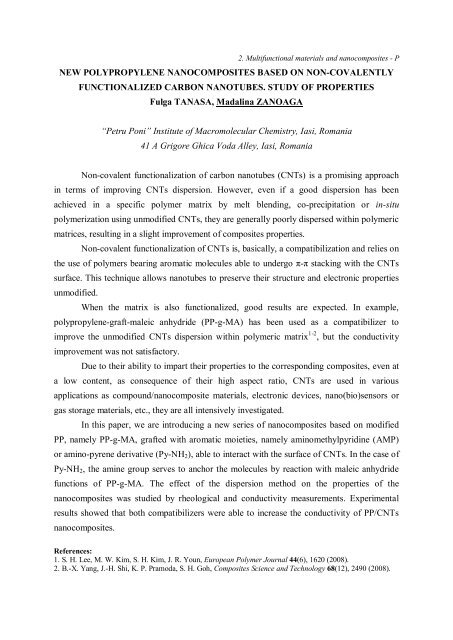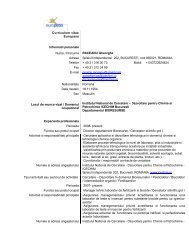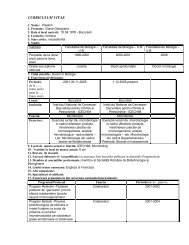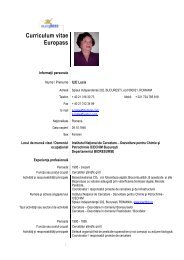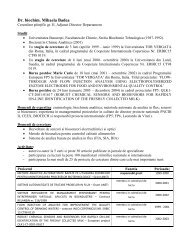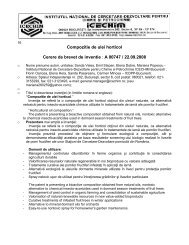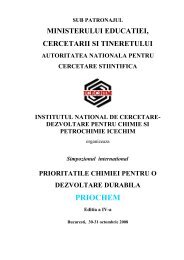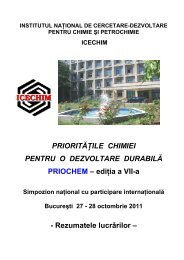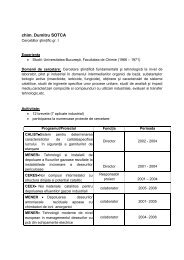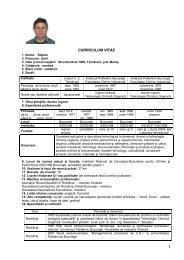INSTITUTUL NAÅ¢IONAL DE CERCETARE-DEZVOLTARE - ICECHIM
INSTITUTUL NAÅ¢IONAL DE CERCETARE-DEZVOLTARE - ICECHIM
INSTITUTUL NAÅ¢IONAL DE CERCETARE-DEZVOLTARE - ICECHIM
- No tags were found...
Create successful ePaper yourself
Turn your PDF publications into a flip-book with our unique Google optimized e-Paper software.
2. Multifunctional materials and nanocomposites - PNEW POLYPROPYLENE NANOCOMPOSITES BASED ON NON-COVALENTLYFUNCTIONALIZED CARBON NANOTUBES. STUDY OF PROPERTIESFulga TANASA, Madalina ZANOAGA“Petru Poni” Institute of Macromolecular Chemistry, Iasi, Romania41 A Grigore Ghica Voda Alley, Iasi, RomaniaNon-covalent functionalization of carbon nanotubes (CNTs) is a promising approachin terms of improving CNTs dispersion. However, even if a good dispersion has beenachieved in a specific polymer matrix by melt blending, co-precipitation or in-situpolymerization using unmodified CNTs, they are generally poorly dispersed within polymericmatrices, resulting in a slight improvement of composites properties.Non-covalent functionalization of CNTs is, basically, a compatibilization and relies onthe use of polymers bearing aromatic molecules able to undergo π-π stacking with the CNTssurface. This technique allows nanotubes to preserve their structure and electronic propertiesunmodified.When the matrix is also functionalized, good results are expected. In example,polypropylene-graft-maleic anhydride (PP-g-MA) has been used as a compatibilizer toimprove the unmodified CNTs dispersion within polymeric matrix 1-2 , but the conductivityimprovement was not satisfactory.Due to their ability to impart their properties to the corresponding composites, even ata low content, as consequence of their high aspect ratio, CNTs are used in variousapplications as compound/nanocomposite materials, electronic devices, nano(bio)sensors orgas storage materials, etc., they are all intensively investigated.In this paper, we are introducing a new series of nanocomposites based on modifiedPP, namely PP-g-MA, grafted with aromatic moieties, namely aminomethylpyridine (AMP)or amino-pyrene derivative (Py-NH 2 ), able to interact with the surface of CNTs. In the case ofPy-NH 2 , the amine group serves to anchor the molecules by reaction with maleic anhydridefunctions of PP-g-MA. The effect of the dispersion method on the properties of thenanocomposites was studied by rheological and conductivity measurements. Experimentalresults showed that both compatibilizers were able to increase the conductivity of PP/CNTsnanocomposites.References:1. S. H. Lee, M. W. Kim, S. H. Kim, J. R. Youn, European Polymer Journal 44(6), 1620 (2008).2. B.-X. Yang, J.-H. Shi, K. P. Pramoda, S. H. Goh, Composites Science and Technology 68(12), 2490 (2008).


